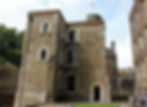The Jewel Tower: A Little Known Corner of Westminster’s Past
3 min readTucked away in a small corner, almost unnoticed near the dominant buildings of the Palace of Westminster and Westminster Abbey, stand the remains of the 14th century Jewel Tower which once held a very significant part in the government of Britain. While the tourists rush to view the highlights, the Slow Traveller can spend an hour learning about some more unusual aspects of the past.

The Jewel Tower was part of the great royal palace of Westminster and is only one of the four palace buildings to survive. From 1042 – 1512 the Palace of Westminster was the main residence for English Kings, and the Jewel Tower was built in 1365 to house Edward III’s gold and silver treasure. The 15th century “Black Book” of Westminster Abbey records the anger of the monks at this area of their land being requisitioned for the tower, and their conviction that the early death of the man responsible, the Keeper of the Palace, William Ussheborne, was through divine retribution for this crime; he died after choking on a fish caught in the tower’s moat, which had also been dug on the abbey’s land.
The tower was constructed with thick stone walls and windows protected by metal grilles and surrounded by a moat for maximum security. You can still feel that sense of strength, power and royal dominance as you climb the spiral staircase and pass through the solid doors with their massive locks. The door to the second chamber on the top floor is made of iron and has the date 1621 and the royal cypher of James I. The original wooden supports of the tower, 650 years old, are on display.
Household plate, goblets, wall-hangings and bedding were also kept here and stored in chests, being sent out in carts or river barges to be used at banquets or royal occasions. The second storey of the tower houses many replicas of such items to give an idea of what was held here.
In 1512 there was a fire in the King’s lodgings so Henry VIII abandoned the Palace of Westminster as a royal residence. The jewel tower remained in use, albeit of less importance. At the end of the 16th century the House of Lords began to use the tower to house its parliamentary records. The first floor has copies of important documents which were once held here – the death warrant of Charles I in 1649, the Bill of Rights of 1688 and the Act of Parliament that abolished slavery in 1833. The records were overseen here by the Clerk of the Parliaments.
In 1869 the Jewel Tower was taken over by the Standard Weights and Measures Department and you can see the official weights which were used as a standardised system of measurement across the country and the British Empire. The tower continued in this role until 1938.
Damage caused through bombing in World War II was repaired in 1948 and the tower is now a tourist attraction run by English Heritage.
VISITING THE JEWEL TOWER
How to get to the Jewel Tower
Postcode: SW1P 3JX
Public Transport: The nearest tube is Westminster, a 7 minute walk
When is the Jewel Tower open?
10am – 5pm daily
How much does it cost to visit the Jewel Tower?
English Heritage members – Free
Adults – £6.80
Concessions £6.50
Children £4.00
Are there any facilities at the Jewel Tower?
There are plenty of loos and restaurants in the Westminster area.



